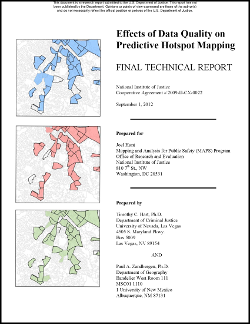
A growing interest and use of crime mapping and analysis among practitioners and academics alike, the potential impact that geocoding results can have on the spatio-temporal analysis of crime, and a sparse literature in this area gave rise to the current study, which was divided into two complementary components.
The aim of the first component of our research was to investigate the relationship between reference data and geocoding quality for crime analysis, whereas the second component of our research was designed to determine the impact of data quality on predictive hotspot mapping techniques. Approximately 400,000 crime incident records from six large law enforcement jurisdictions in the U.S. were analyzed: Arlington Police Department (TX), Albuquerque Police Department (NM), Charlotte-Mecklenburg Police Department (NC), Las Vegas Metropolitan Police Department (NV), San Diego County Sheriff’s Office (CA), and Tampa Police Department (FL).
Completeness and positional accuracy of geocoding results was assessed across several crime types as well as different levels of input address quality, using both commercial and non-commercial street network reference data. Results suggest that 1) the type of reference data (e.g., streets, parcel centroids, or address points) used in the geocoding process affects geocoding quality; 2) match rates vary by crime type and are influenced greatly by the quality of input addresses; 3) the type of reference data in conjunction with crime type influences geocoding quality considerably; 4) the type of reference data used in the geocoding process affects geocoding quality, measured in terms of positional accuracy; and 5) positional accuracy of geocoded crime incidents is influenced greatly by crime type.
Predictive accuracy of hotspot maps was based on three metrics, including hit rate, Predictive Accuracy Index (PAI), and Recapture Rate Index (RRI). Findings show that the effect of geocoding quality on predictive hotspot crime mapping varies by crime type, urban morphology, and technique, as well as parameter settings associated with them. More importantly, findings suggest that the effect of geocoding quality on predictive hotspot mapping is complex and often mitigated by many of the aforementioned factors.
In sum, findings suggest that no one predictive hotspot mapping technique is superior to any other.
The study’s contribution to the literature, limitations, and implications for future research are discussed. More importantly, specific recommendations related to both geocoding and hotspot analyses are offered.
